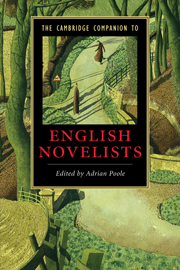Book contents
- Frontmatter
- Introduction
- 1 Daniel Defoe
- 2 Samuel Richardson
- 3 Henry Fielding
- 4 Laurence Sterne
- 5 Frances Burney
- 6 Jane Austen
- 7 Walter Scott
- 8 Charles Dickens
- 9 William Makepeace Thackeray
- 10 Charlotte Brontë
- 11 Emily Brontë
- 12 Elizabeth Gaskell
- 13 Anthony Trollope
- 14 George Eliot
- 15 Thomas Hardy
- 16 Robert Louis Stevenson
- 17 Henry James
- 18 Joseph Conrad
- 19 D. H. Lawrence
- 20 James Joyce
- 21 E. M. Forster
- 22 Virginia Woolf
- 23 Elizabeth Bowen
- 24 Henry Green
- 25 Evelyn Waugh
- 26 Graham Greene
- 27 William Golding
- Guide to further reading
- Index
5 - Frances Burney
Published online by Cambridge University Press: 28 March 2010
- Frontmatter
- Introduction
- 1 Daniel Defoe
- 2 Samuel Richardson
- 3 Henry Fielding
- 4 Laurence Sterne
- 5 Frances Burney
- 6 Jane Austen
- 7 Walter Scott
- 8 Charles Dickens
- 9 William Makepeace Thackeray
- 10 Charlotte Brontë
- 11 Emily Brontë
- 12 Elizabeth Gaskell
- 13 Anthony Trollope
- 14 George Eliot
- 15 Thomas Hardy
- 16 Robert Louis Stevenson
- 17 Henry James
- 18 Joseph Conrad
- 19 D. H. Lawrence
- 20 James Joyce
- 21 E. M. Forster
- 22 Virginia Woolf
- 23 Elizabeth Bowen
- 24 Henry Green
- 25 Evelyn Waugh
- 26 Graham Greene
- 27 William Golding
- Guide to further reading
- Index
Summary
Had this collection of essays been produced only a decade - certainly two decades - ago, it is by no means certain that Frances Burney would have been included. To her contemporaries and immediate successors, Burney (1752-1840) was a major figure: an innovative pioneer in the development of the novel and a significant contributor to its rapid growth in status and respectability at the end of the eighteenth century. Following the publication of her first two novels, Evelina (1778) and Cecilia (1782), critics and influential cultural commentators such as Samuel Johnson and Elizabeth Montagu hailed Burney as successor to the already highly respected male novelists of the mid-century. Her fiction was seen to combine 'the dignity and pathos of Richardson' with 'the acuteness and ingenuity of Fielding'. Jane Austen's well-known defence of novels in Northanger Abbey cites Cecilia, together with Burney's third novel, Camilla (1796), as exemplars of the form 'in which the greatest powers of the mind are displayed, in which the most thorough knowledge of human nature, the happiest delineation of its varieties, the liveliest effusions of wit and humour are conveyed to the world in the best chosen language'. And Anna Letitia Barbauld included all three novels in her monumental canon-making collection, The British Novelists (1810), prefacing them with the by then established judgement that: 'Scarcely any name, if any, stands higher in the list of novel-writers than that of Miss Burney. ' But with the publication in 1814 of Burney's fourth and final novel, The Wanderer, her canonical status began to look more precarious - and it remained so, until feminist and historicist critics at the end of the twentieth century (re)discovered how to read her fiction in ways which have begun to restore her to a deservedly more secure position.
- Type
- Chapter
- Information
- The Cambridge Companion to English Novelists , pp. 80 - 97Publisher: Cambridge University PressPrint publication year: 2009

